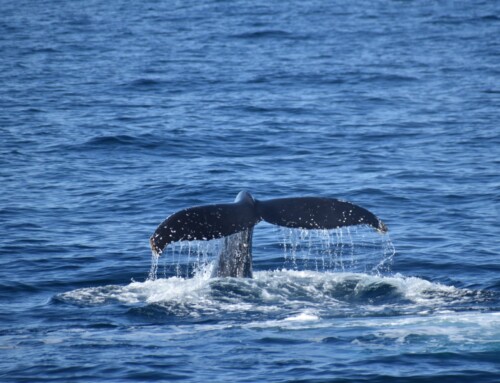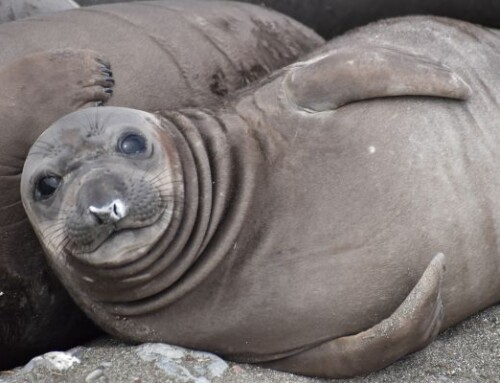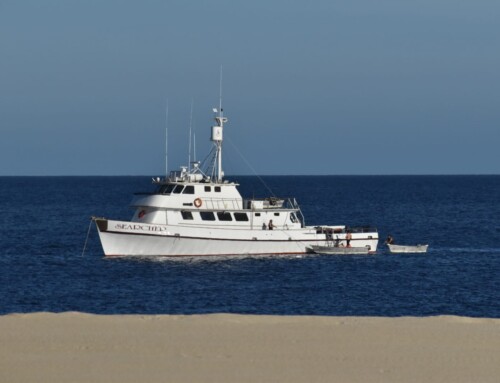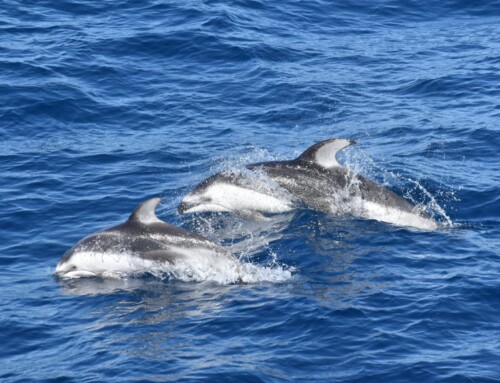DATE: September 4-8, 2006
TRIP: Offshore Birding Trip
Trip Route (click for larger)
Report
Leaders: Todd McGrath, Steve Howell, Don Desjardin
Sept 4th

After stowing our gear and checking out our bunks, it was out on deck to start birding. The harbor in San Diego is an excellent place to bird, and our efforts were rewarded with good looks at some of the coastal species. A single Caspian Tern was noted along with many Elegants. A stop at the bait barge revealed hundreds of Brandt’s and a few Double-crested Cormorants. A few herons and egrets were also present along with high numbers of Western and Heerman’s Gulls.
Once we rounded Pt Loma and proceeded offshore, we were rewarded with excellent looks at Black-vented Shearwaters. This nearshore species normally does not arrive in numbers until October, but this year they arrived in July, our 1,500 plus was the most recorded on a fall Searcher trip. A Sabine’s Gull was also present very close to shore along with large numbers of Common and Elegant Terns. A single Least Tern was at the end of the window for this species.
Soon we began to record some storm-petrels, and mixed in with the expected Black Storm-petrels we found some Leach’s and at least 3 Ashy. Although Leach’s breed on the Coranado islands near San Diego, they are seldom seen close to shore. Ashy breed on the Channel Islands, but are rare near San Diego. Both were firsts in San Diego county for some of the leaders.
Further offshore a few Pink-footed Shearwaters were sighted, but our biggest surprise of the day was an adult Red-billed Tropicbird spotted just 9 miles off San Diego. Tropicbirds are occasionally recorded this close to the coast, but it was the first San Diego sighting for any Searcher birding trip (although every trip has recorded this species somewhere else along the route). Another Tropicbird 15 miles off the coast was another highlight.
The weather forecast was for a bit of wind and chop, so we stayed close to shore as we headed north to the northern Channel Islands. After a fine Dinner we all headed off to our bunks to catch some sleep.
Sept 5th
This day is usually spent around the Northern Channel Islands, and is often the birdiest day of the trip. The cold water around the channel islands is rich in marine life, and both whales and birds are usually present in numbers. We encountered thousands of Pink-footed Shearwaters south of Santa Cruz Island, with hundreds of Sooty Shearwaters. We also found our first South Polar Skuas as well as Pomarine, Parasitic and Long-tailed Jaegers (The “Skua Slam”). This day was also our best day for alcids with Common Murre, Pigeon Guillemot, and Cassin’s and Rhinoceros Auklets all being recorded. We would also record one of our only two Northern Fulmars for the trip. The blustery weather continued and we decided the cross the Santa Barbara channel and anchor near Pt Conception, where we could enjoy a comfortable dinner and get some sleep free from the wind and waves. On our passage across, we encountered numbers of Black-vented Shearwaters again.
September 6th
We pulled up anchor at 3:30 Am and headed southwest for the deep waters off the continental shelf. These deep waters are often rather unproductive, and we recorded only a few Sooty and Pink-footed shearwaters, but this was our best day for Buller’s Shearwaters. This species is often more common in the deeper waters, and this fall was no exception. Our first Black-footed Albatrosses put in appearance, and several Least Storm-petrels were seen distantly. Leach’s Storm-petrels are often abundant in these deep, warm waters, and we saw over 200 today.
By afternoon,we had crossed the San Juan Seamount, and were headed south east, over a deep 2000+ fathom shelf break. We had to see any of the Cook’s Petrels we were hoping for (there were numbers here last year). Todd McGrath spotted a distant bird arcing up on the horizon that didn’t look quite right, and he asked the captain to stop the boat, as the bird was headed towards us. The high arcing flight looked good for a Pteradroma petrel, but it seemed to big and dark for a Cook’s. The participants were all instructed to get on the bird as it approached, but Todd still wasn’t sure what it was. As it arced up and showed an all dark back, he thought it might be a Pink-footed shearwater. The next arc the bird showed it’s ventral surface, and the call of “Dark-rumped Petrel” was made. A few photos were snapped as the bird zipped up the port side. There are about 20 records for Dark-rumped Petrel in CA, but only three of these are from Southern California. A quick check of our position indicated we were in Ventura County (about 75 nmi sw of San Nicolas I.). We had just added a species to the Ventura County checklist, and many on the boat had added a life bird.
September 6th
We started the morning in deep water west of the Cortez Bank. Our first surprise of the morning was a Lesser Nighthawk making repeated passes around the boat at dawn. This was the first time I had seen this species offshore, but there are other pelagic records for this species. Next we crossed the bank, finding few birds with the exception of Leach’s storm-petrels and a few Black-footed Albatrosses. This final day is often hit or miss, and this year it was mostly miss until we arrived at the Sixty-mile Bank in the late afternoon. A large slick here attracted many Leach’s and Black-storm Petrels. A diligent search through the flocks eventually led to good looks for all at Least Storm-petrels. These small petrels can often be difficult to pick out of a large flock, but the leaders worked diligently to ensure that everyone could pick them out. After a fine dinner, we all headed off to sleep, and pack for our early morning arrival back in San Diego.
Picture Gallery
| 4-Sep | 5-Sep | 6-Sep | 7-Sep | Total | |
| Birds | |||||
| Northern Shoveler | 0 | 6 | 0 | 0 | 6 |
| Black-footed Albatross | 0 | 0 | 7 | 6 | 13 |
| Northern Fulmar | 0 | 1 | 1 | 0 | 2 |
| Dark-Rumped Petrel | 0 | 0 | 1 | 0 | 1 |
| Pink-footed Shearwater | 20 | 2000 | 1 | 2 | 2023 |
| Buller’s Shearwater | 0 | 2 | 19 | 0 | 21 |
| Sooty Shearwater | 0 | 600 | 9 | 2 | 611 |
| Black-vented Shearwater | 1500 | 300 | 0 | 0 | 1800 |
| Leach’s Storm-petrel | 7 | 0 | 83 | 200 | 290 |
| Ashy Storm-petrel | 3 | 1 | 1 | 0 | 5 |
| Black Storm-petrel | 30 | 0 | 10 | 55 | 95 |
| Least Storm-petrel | 0 | 0 | 1 | 5 | 6 |
| Red-billed Tropicbird | 2 | 0 | 1 | 1 | 4 |
| Brown Pelican | 250 | 75 | 0 | 2 | 327 |
| Double Crested Cormorant | 9 | 5 | 0 | 0 | 14 |
| Pelagic Cormorant | 2 | 3 | 0 | 0 | 5 |
| Brandt’s Cormorant | 500 | 20 | 0 | 0 | 520 |
| Great-Blue Heron | 6 | 0 | 2 | 0 | 8 |
| Great Egret | 6 | 0 | 0 | 0 | 6 |
| Snowy Egret | 14 | 0 | 0 | 0 | 14 |
| Black-crowned Night-Heron | 2 | 0 | 0 | 0 | 2 |
| Red-necked Phalarope | 200 | 9 | 0 | 7 | 216 |
| Red Phalarope | 6 | 3 | 7 | 41 | 57 |
| South Polar Skua | 0 | 5 | 0 | 0 | 5 |
| Pomarine Jaeger | 1 | 14 | 5 | 1 | 21 |
| Parasitic Jaeger | 2 | 2 | 0 | 1 | 5 |
| Long-tailed Jaeger | 0 | 1 | 4 | 1 | 6 |
| Sabine’s Gull | 4 | 1 | 1 | 0 | 6 |
| California Gull | 105 | 2 | 0 | 0 | 107 |
| Heerman’s Gull | 192 | 19 | 0 | 0 | 211 |
| Western Gull | 475 | 382 | 0 | 25 | 882 |
| Least tern | 1 | 0 | 0 | 0 | 1 |
| Caspian Tern | 1 | 0 | 0 | 0 | 1 |
| Common Tern | 500 | 0 | 0 | 0 | 500 |
| Arctic Tern | 0 | 0 | 7 | 6 | 13 |
| Royal Tern | 10 | 2 | 0 | 0 | 12 |
| Elegant Tern | 200 | 50 | 0 | 0 | 250 |
| Common Murre | 0 | 1 | 0 | 0 | 1 |
| Pigeon Guillemot | 0 | 3 | 0 | 0 | 3 |
| Murrelet sp. | 0 | 0 | 2 | 1 | 3 |
| Cassin’s Auklet | 0 | 5 | 0 | 9 | 14 |
| Rhinocerous Auklet | 0 | 4 | 0 | 0 | 4 |
| Mourning Dove | 0 | 1 | 0 | 0 | 1 |
| Lesser Nighthawk | 0 | 0 | 0 | 1 | 1 |
| Western Tanager | 0 | 0 | 0 | 1 | 1 |
| Brown-headed Cowbird | 0 | 0 | 2 | 1 | 3 |
| Marine Mammals | |||||
| Sea Otter | 0 | 52 | 0 | 0 | 52 |
| Guadalupe Fur Seal | 0 | 0 | 4 | 0 | 4 |
| Northern Fur Seal | 0 | ||||
| California Sea Lion | 152 | 42 | 0 | 6 | 200 |
| Harbor Seal | 2 | 0 | 0 | 0 | 2 |
| Blue Whale | 1 | 3 | 0 | 0 | 4 |
| Fin Whale | 4 | 7 | 0 | 0 | 11 |
| Sei Whale | 0 | 0 | 0 | 1 | 1 |
| Short-beaked Common Dolphin | 200 | 70 | 0 | 270 | |
| Long-beaked Common Dolphin | 50 | 0 | 0 | 0 | 50 |
| Common Dolphin Sp | 0 | 200 | 0 | 0 | 200 |







